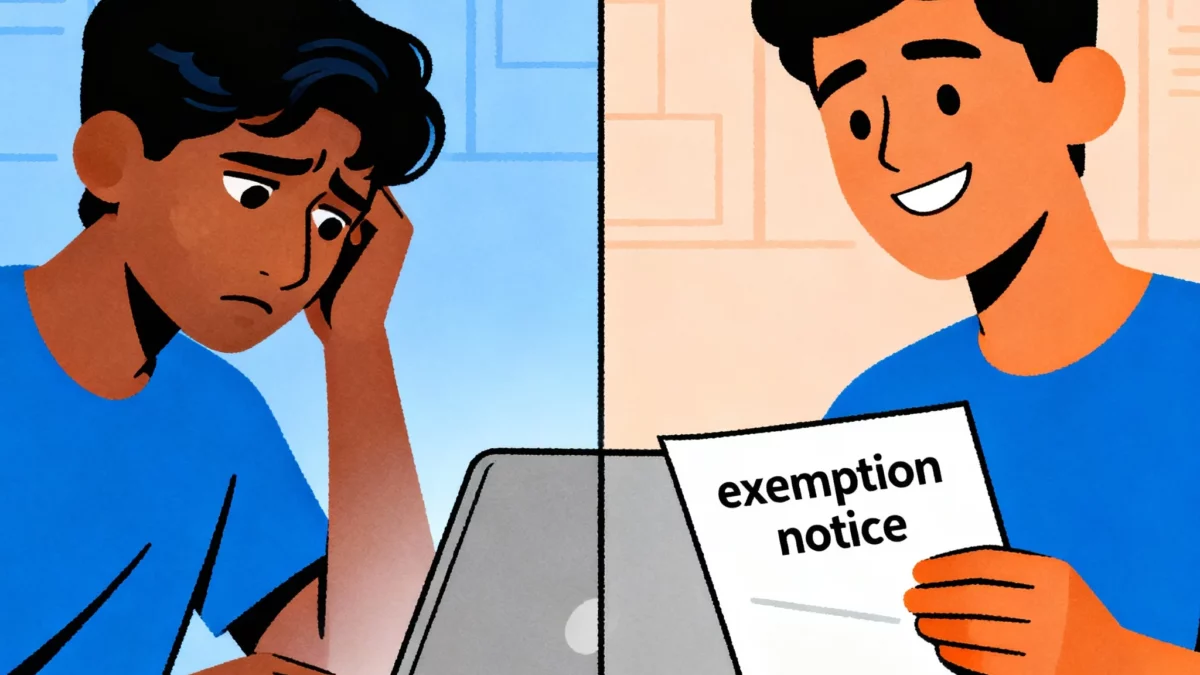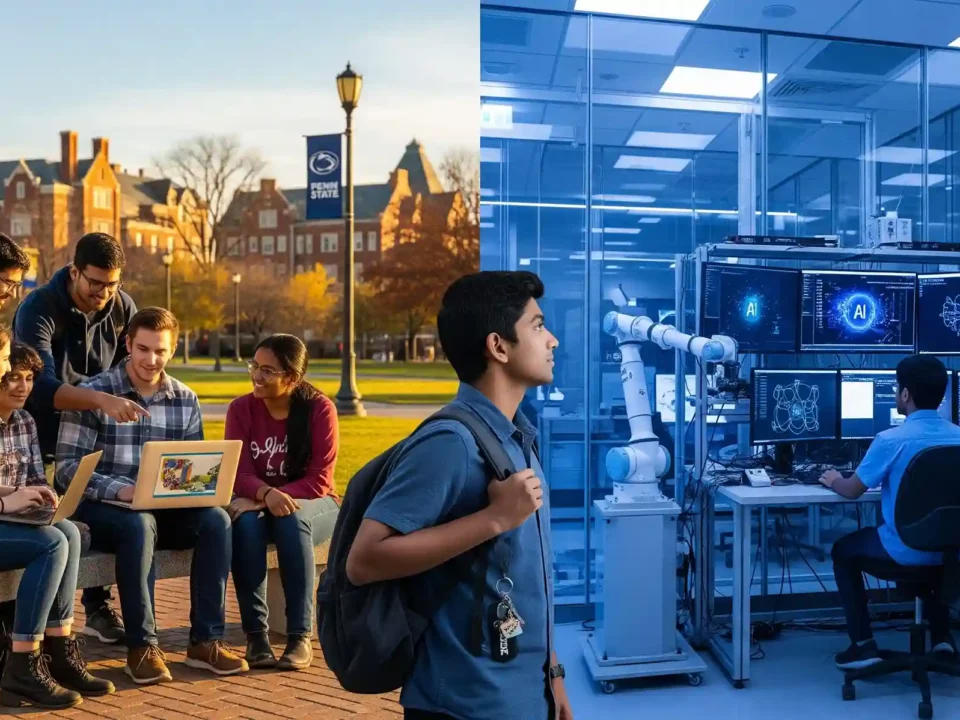The $100K H1B Fee Truth: Why Your F1 Dream Isn’t Dead

Estimated reading time: 16 minutes
Remember September 2025? The month every Indian student’s WhatsApp exploded with panic messages about studying in America. Your consultant probably called you urgently, suggesting you “reconsider” the US and look at Germany instead. Meanwhile, your parents forwarded that viral post about the $100,000 H1B fee, asking if you should cancel your applications.
Table of contents
- What Actually Happened in September 2025
- How the Panic Started (And Why It Wasn’t Your Fault)
- The Truth About $100k H1B Fee F1 Students Need to Know
- Why Some Students Still Shifted to Other Countries
- What Actually Changed (And What Didn’t)
- Why European Alternatives Aren’t Necessarily “Better”
- How to Make Smart Decisions Despite the Noise
- What You Should Do Right Now
- If You’re Applying for Spring 2026/Fall 2026
- The Real Lessons from September 2025
- How Bluehawks Cuts Through the Confusion
- Your Next Steps
- The Bottom Line
Here’s what actually happened: F1 students were never affected by the $100k H1B fee. Not even a little bit. Yet thousands of students shifted their plans to other countries based on incomplete information. In fact, your pathway from F1 visa to H1B work authorization remains completely intact—and in some ways, it’s actually stronger now.
Let me walk you through what really went down, why the confusion spread like wildfire, and most importantly, what this means for your American dream.
What Actually Happened in September 2025
On September 19, 2025, the Trump administration announced a new policy that sent shockwaves through the education industry. Specifically, they introduced a $100,000 fee for certain H1B visa applications. Within hours, social media erupted with panic, and education consultants started redirecting students to European universities.
However, there was a critical detail buried in the policy announcement. The $100k H1B fee F1 students were worried about? It doesn’t apply to them at all.
Let me explain exactly what the policy says—in plain English, not legal jargon.
Who Actually Pays the $100K Fee
The fee applies exclusively to companies hiring workers directly from abroad through the H1B lottery system. Think of it this way: if a company in California wants to hire a software engineer currently living in Bangalore and bring them to the US on an H1B visa, that’s when the $100,000 fee kicks in.
On the other hand, if you come to America as an F1 student, complete your degree, work on OPT (Optional Practical Training), and then your employer sponsors you for H1B—there’s no $100,000 fee. None. Zero. Zilch.
Why This Distinction Matters
The US government deliberately designed this policy to favor international students who graduate from American universities. In other words, they want to make it easier for you (an F1 student) to stay and work, while making it more expensive for companies to bypass the US education system entirely.
Nevertheless, this crucial exemption got completely lost in the initial panic.
How the Panic Started (And Why It Wasn’t Your Fault)
You probably saw the headlines first on Instagram or LinkedIn. “Trump Adds $100K Fee to H1B Visas” screamed across your feed. Within minutes, your study abroad WhatsApp group was flooded with worried messages. By evening, your consultant was calling with “urgent news.”
But here’s the thing: nobody was lying to you. Instead, everyone was working with incomplete information during those first chaotic 48 hours.
The Confusion Timeline
Day 1 (September 19): The White House announcement used broad language that seemed to cover “all H1B petitions”. Immigration lawyers themselves weren’t sure about exemptions initially. Furthermore, different government departments gave conflicting interpretations.
Day 2 (September 20): Social media amplified the panic. The hashtag #H1BPanic started trending in India. Meanwhile, concerned parents called their kids studying in America, asking if they should come home immediately.
Day 3 (September 21): Education consultants, facing dozens of panicked calls, started advising students to consider backup options. Consequently, many began actively promoting European universities as “safer alternatives”.
Day 4-5 (September 22-23): Official clarifications finally emerged confirming that F1 to H1B transitions were exempt. However, by then, the damage was done. Thousands of students had already shifted their plans.
Why Consultants Pivoted So Quickly
Let’s be real for a minute. Traditional education consultants aren’t necessarily trying to mislead you, but they do have business pressures you should understand.
First of all, when uncertainty hits one market, consultants naturally redirect clients to destinations where outcomes are more predictable. After all, their commission depends on successfully placing you somewhere, and uncertain policies make conversions harder.
Additionally, some consultancies had already been building their European university partnerships. The H1B confusion became, quite frankly, a convenient marketing opportunity. “Avoid H1B hassles—study in Germany!” became a common pitch almost overnight.
Moreover, consultants were genuinely working with incomplete information during those first 48 hours. In the absence of clarity, recommending “safer” alternatives seemed like responsible advice.
Nevertheless, the rapid pivot away from the US revealed something important: many consultants prioritized quick placements over digging into the actual policy details that affected F1 students specifically.
The Truth About $100k H1B Fee F1 Students Need to Know
Alright, let’s get crystal clear on the facts. I’m going to break this down step-by-step so there’s absolutely no confusion.
What the Fee Actually Covers
The $100,000 fee applies ONLY when:
- A company files a brand new H1B petition for someone currently living outside the United States
- The person has never held US work authorization before
- It’s a direct hire from overseas through the H1B lottery
In other words, the fee targets companies doing direct international recruitment, not students who are already in the US education system.
What Is Completely Exempt
The $100k H1B fee F1 students were panicking about? Here’s what’s explicitly exempt:
✅ F1 students changing status to H1B after graduation
✅ Optional Practical Training (OPT) workers transitioning to H1B
✅ STEM OPT extension holders (24 additional months)
✅ H1B renewals and extensions
✅ Cap-exempt H1B positions (universities, research institutions)
Furthermore, the exemption isn’t some loophole that might close later. It’s explicitly written into the policy because the entire point was to favor US-educated candidates.
Your F1 to H1B Pathway (Still Intact)
Let me walk you through exactly how your pathway works, because this is crucial to understand.
Step 1: F1 Visa
You arrive in the US on a student visa to pursue your degree. This part hasn’t changed at all.
Step 2: Complete Your Degree
You spend 2-4 years earning your Bachelor’s or Master’s degree from a US university. Again, completely unchanged.
Step 3: Optional Practical Training (OPT)
After graduation, you’re eligible for 12 months of work authorization in your field of study. Importantly, this applies to ALL majors, not just STEM.
Step 4: STEM OPT Extension (If Applicable)
If you studied a STEM field (Science, Technology, Engineering, or Mathematics), you get an additional 24 months of work authorization. Therefore, STEM students have a total of 36 months (three full years) to work in the US.
Step 5: H1B Application
During your OPT period, your employer sponsors you for an H1B visa. They enter you into the annual H1B lottery, typically in March.
Step 6: Status Change
If selected in the lottery, you change your status from F1 to H1B while remaining in the United States. This is the key part: you never leave the US, so the $100,000 fee doesn’t apply.
In fact, this entire pathway costs your employer the standard H1B filing fees (around $4,000-$6,000), not $100,000.
Why Some Students Still Shifted to Other Countries
Despite the exemption, the September panic had real consequences. According to industry data, US study inquiries from Indian students dropped by 63% in the two weeks after the announcement. Meanwhile, Germany saw a 45% increase, the UK 38%, and Ireland 52% during the same period.
So what happened? Why did students abandon their US plans even after the truth came out?
The Trust Factor
Honestly, the September confusion reinforced a broader narrative about US immigration unpredictability. For many families, it was the last straw after years of watching visa policies change under the Trump administration.
Moreover, even though the $100k H1B fee F1 students heard about didn’t apply to them, the episode raised legitimate questions: “What if they change the rules again? What if OPT gets restricted next? Can we really plan a 5-year pathway when policies shift overnight?”
These concerns aren’t baseless. In fact, the Trump administration has proposed other changes affecting F1 students, including increased 214B social media vetting and potential modifications to “duration of status” rules.
Consultant Influence
Let’s be honest about another factor: once consultants pivoted their messaging, momentum built quickly. Students who were “on the fence” about the US suddenly had a professional telling them, “Let’s look at Germany—it’s safer, cheaper, and less stressful.”
Additionally, some consultants genuinely believed they were protecting their clients by diversifying options. However, the speed of the pivot—often within 24 hours—suggests that business considerations played a role too.
Information Overload
During those chaotic September days, students received contradictory information from multiple sources. Your consultant said one thing, Instagram said another, and your uncle in California said something completely different. In that environment, paralysis or pivoting to “safer” options made sense.
Nevertheless, many of these decisions were made without understanding the actual F1 exemption.
What Actually Changed (And What Didn’t)
Let’s create absolute clarity here with a straightforward comparison.
What Changed in September 2025
Direct overseas H1B hiring now costs companies $100,000 for initial petitions. Consequently, employers have stronger incentives to hire candidates already in the US on F1/OPT status rather than recruiting directly from abroad.
Processing priorities shifted slightly to favor US degree holders. In other words, USCIS indicated they would prioritize change-of-status applications from F1 to H1B.
Market perception of US immigration became more unstable. Therefore, even though your pathway remains intact, the overall sentiment among students shifted.
What Stayed Exactly the Same
F1 visa availability is unchanged. Qualified students can still obtain F1 visas at the same rates as before.
OPT eligibility remains 12 months for all graduates, plus 24 months extension for STEM fields. Importantly, there were zero changes to this program.
F1 to H1B pathway is completely intact with no $100,000 fee for status changes filed within the US.
H1B lottery odds for US degree holders remain the same. In fact, you still get the benefit of the advanced degree exemption if you have a US Master’s.
University cap-exempt H1B positions (academic jobs, research institutions) are entirely unaffected.
What Actually Improved for F1 Students
Here’s something most consultants won’t tell you: the new policy might actually help F1 students.
Increased competitive advantage: Companies now have a strong financial incentive ($100,000 difference!) to hire you instead of someone abroad. As a result, your value as an F1/OPT candidate just increased significantly.
Faster processing: USCIS has indicated priority for US-based status changes, meaning your H1B application might be processed more quickly than before.
University lobbying power: American universities successfully protected the F1 student pipeline because international students contribute $9 billion annually to the US economy. Therefore, they have strong incentives to keep your pathway open.
Why European Alternatives Aren’t Necessarily “Better”
Look, Germany, Ireland, and the UK are genuinely excellent study destinations. I’m not here to bash European education. However, the narrative that they’re universally “safer” or “better” than the US deserves some scrutiny.
The European Reality Check
Germany offers tuition-free education, which is genuinely attractive. However, you’ll need to learn German for most job opportunities, and the 18-month post-study work visa is significantly shorter than US OPT/STEM OPT. Moreover, average salaries for entry-level jobs are considerably lower than US tech salaries.
UK provides a 2-year Graduate Route visa, but the pathway to permanent residency is less clear-cut than consultants often suggest. Additionally, tuition fees rival US costs at top universities.
Ireland has a thriving tech sector and a 2-year post-study work visa. Nevertheless, the job market is much smaller than the US, meaning fewer opportunities overall.
Canada offers the clearest path to permanent residency through Express Entry. However, the recent surge in international students has led to housing crises and job market saturation in cities like Toronto and Vancouver.
The US Still Offers Unique Advantages
Salary potential in the US tech sector far exceeds European alternatives. A software engineer in San Francisco earns 2-3x more than their counterpart in Berlin or Dublin.
Industry leadership means the US remains home to the world’s most innovative companies. If you want to work at the cutting edge of AI, biotech, or aerospace, the US has more opportunities.
University prestige and research funding at top US institutions still surpass most European alternatives. Consequently, the degree you earn carries significant global weight.
OPT/STEM OPT duration gives you up to 36 months of work authorization, longer than most European post-study visas.
How to Make Smart Decisions Despite the Noise
Alright, so where does this leave you? How do you make an informed decision when consultants, social media, and even well-meaning relatives are giving you conflicting advice?
Step 1: Verify Information from Official Sources
Always, always check official government websites before making major decisions:
- USCIS.gov for H1B and OPT information
- Travel.state.gov for F1 visa details
- StudyInTheStates.dhs.gov for international student regulations
Social media and consultant opinions should be secondary to these official sources. Furthermore, immigration attorney blogs (from licensed professionals, not random influencers) can provide valuable interpretations.
Step 2: Understand Your Specific Situation
The best destination depends on your individual circumstances:
If you’re studying STEM: The US offers 36 months of work authorization and three chances at the H1B lottery. This is genuinely hard to beat.
If you’re in humanities or business: Consider whether the US job market in your field justifies the higher education costs versus European alternatives.
If your goal is permanent residency: Canada and Australia offer clearer pathways than the US H1B lottery system. However, the US still offers routes through employment-based green cards if you’re patient.
If you have limited budget: Germany’s tuition-free education is genuinely attractive, but factor in living costs and lower post-graduation salaries.
Step 3: Build Plan A, B, and C
Smart students in 2025 aren’t putting all their eggs in one basket. Instead, they’re building multiple scenarios:
Plan A: US via F1 → OPT → H1B pathway
Plan B: European alternative (Germany, Ireland, Netherlands)
Plan C: Canada or Australia post-study work visa
This isn’t abandoning your US dream—it’s strategic planning in an uncertain environment. Moreover, applying to universities in multiple countries gives you leverage during visa interviews.
Step 4: Choose Consultants Carefully
Not all education consultants are created equal. Look for consultants who:
✅ Provide fact-based advice with references to official sources
✅ Have recent successful F1 visa case studies (especially 214B refusal recoveries)
✅ Stay updated on policy changes rather than relying on outdated information
✅ Present balanced pros and cons rather than pushing specific destinations
✅ Specialize in your target destination and field of study
On the other hand, be wary of consultants who:
❌ Use fear tactics (“The US is closing down!”)
❌ Push you toward specific countries without understanding your goals
❌ Can’t explain recent policy changes accurately
❌ Make guarantees about visa approvals
❌ Pivot their recommendations based on headlines rather than facts
Step 5: Consider Your Risk Tolerance
Here’s an honest assessment: US immigration policy is less predictable than Canada’s Express Entry or Australia’s points system. If you have very low tolerance for uncertainty, European destinations with straightforward post-study work visas might suit you better.
However, if you:
- Have strong qualifications (especially STEM)
- Are comfortable navigating complexity
- Value the US job market and salary potential
- Can commit to a 3-5 year pathway
…then the US remains one of the strongest options available, despite the noise.
What You Should Do Right Now
If you’re currently planning your study abroad journey, here’s my practical advice:
If You’re Applying for Spring 2026/Fall 2026
Don’t abandon your US applications based on the $100k H1B fee F1 students heard about. Remember, it doesn’t apply to you.
Do diversify by applying to 2-3 countries if you’re concerned about visa uncertainty. This gives you options and negotiating power.
Focus on building a strong F1 visa profile rather than worrying about H1B policies that won’t affect you for 3-4 years. Moreover, policies will likely change again by then anyway.
If You’re Already in the US on F1
Relax. Your pathway to OPT and H1B remains completely intact. In fact, you might have a competitive advantage now that direct overseas hiring is more expensive.
Maximize your OPT period by building strong relationships with employers who might sponsor your H1B. Additionally, if you’re in STEM, make sure you apply for the 24-month extension to get three lottery chances.
Stay informed about policy changes, but don’t panic over every headline. Furthermore, your university’s international student office is your best resource for accurate, timely information.
If You’re on OPT Preparing for H1B
Your employer will NOT pay a $100,000 fee for your H1B application since you’re doing a status change within the US. Make sure they understand this distinction.
Prepare your H1B application thoroughly. The lottery odds haven’t changed, so focus on what you can control: a strong employment relationship and complete documentation.
Consider STEM OPT extension if you’re in year one of OPT and have a STEM degree. This gives you two more years and additional lottery chances.
The Real Lessons from September 2025
Looking back at the September panic, what should we learn?
Lesson 1: Headlines Rarely Tell the Full Story
The initial announcement about the $100k H1B fee F1 students saw everywhere? It was technically accurate but completely misleading without the exemption details. Therefore, always dig deeper than headlines before making life-changing decisions.
Lesson 2: Consultant Interests Don’t Always Align with Yours
Many consultants genuinely try to help students. However, their business model creates incentives that don’t always align with your best interests. Consequently, treat consultant advice as one input among many, not gospel truth.
Lesson 3: Official Sources Beat Social Media
Instagram infographics and WhatsApp forwards are terrible sources for immigration policy information. Instead, bookmark official government websites and check them first when news breaks.
Lesson 4: Diversification Reduces Anxiety
Students who had applied to multiple countries felt less panic during September. Moreover, having options gives you power during visa interviews and salary negotiations later.
Lesson 5: The US Pathway Still Works
Despite the chaos, tens of thousands of Indian F1 students are successfully transitioning to H1B every year. Furthermore, the fundamental pathway hasn’t changed—it’s just noisier now.
How Bluehawks Cuts Through the Confusion
At Bluehawks EduAbroad, we watched the September panic unfold in real-time. We saw students making fear-based decisions with incomplete information. We heard from dozens of families who had been advised to abandon their US plans despite the F1 exemption.
That’s exactly why we do what we do differently.
We Prioritize Facts Over Fear
When the $100k H1B fee F1 students were panicking about was announced, we didn’t immediately pivot our messaging. Instead, we:
✅ Read the full policy text
✅ Consulted with immigration attorneys
✅ Waited for official clarifications
✅ Then advised our students accurately
As a result, our students made informed decisions rather than fear-based ones.
We Specialize in F1 Complexity
Our expertise is specifically in the F1 visa process, including:
- F1 visa interview preparation that addresses your unique profile
- 214B refusal analysis and re-application strategy
- OPT to H1B transition planning with timeline management
- Policy update interpretation so you understand what actually affects you
Furthermore, we’ve helped hundreds of students navigate successfully, including many who had faced 214B refusals and successfully reapplied.
We’re Transparent About Trade-offs
We won’t tell you the US is perfect or that European alternatives are inferior. Instead, we help you understand:
- Real pros and cons of each destination
- How your specific profile affects success odds
- What pathways align with your career goals
- Where you’re likely to thrive personally and professionally
Your Next Steps
If you’re feeling overwhelmed by conflicting information about the $100k H1B fee F1 students face (spoiler: you don’t face it!), here’s what to do:
Immediate Actions:
- Bookmark this article to re-read when anxiety strikes
- Visit official USCIS and State Department websites for current policy details
- Stop following social media accounts that post fear-based content without official sources
For Current Applicants:
- Continue your US university applications if that’s your goal
- Build a strong F1 visa profile with clear academic and career objectives
- Consider applying to 1-2 backup destinations for peace of mind
For Decision Support:
- Schedule a consultation with specialists (like Bluehawks EduAbroad) who focus specifically on F1 visas
- Talk to current F1 students and recent graduates about their experiences
- Evaluate your options based on facts and your goals, not consultant business interests
The Bottom Line
Let me say this as clearly as possible: The $100k H1B fee F1 students heard about in September 2025 does not apply to you. Your pathway from F1 visa through OPT to H1B work authorization remains completely intact. In fact, it may be stronger now than before.
Yes, US immigration policy is unpredictable. Yes, there are legitimate concerns about visa processing and policy volatility. And yes, European alternatives offer genuine advantages for some students.
However, abandoning your US dreams based on misinformation serves nobody except consultants with European university partnerships.
The American dream hasn’t become $100,000 more expensive for F1 students. It’s as accessible as it was before September—perhaps even more so for those with US degrees.
So take a breath. Verify your information from official sources. Make decisions based on your goals and circumstances, not fear and headlines.
And remember: the best consultant is the one who gives you facts, not fear.
💬 Chat with our 24/7 chat support team, just tap on that WhatsApp button on the right bottom of your screen 👉



